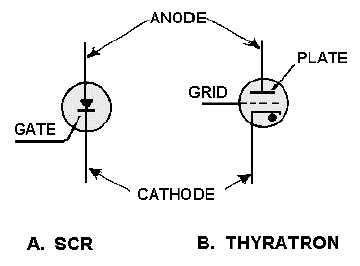3-23
conduction (about 5 microseconds in resistive-load circuits). After conduction from cathode to anode
begins, removing the gate current has no effect.
The basic operation of the SCR can be compared to that of the thyratron. The thyratron is an electron
tube, normally gas filled, that uses a filament or a heater. The SCR and the thyratron function in a very
similar manner. Figure 3-21 shows the schematic of each with the corresponding elements labeled. In
both types of devices, control by the input signal is lost after they are triggered. The control grid
(thyratron) and the gate (SCR) have no further effect on the magnitude of the load current after
conduction begins. The load current can be interrupted by one or more of three methods: (1) the load
circuit must be opened by a switch, (2) the plate (anode) voltage must be reduced below the ionizing
potential of the gas (thyratron), (3) the forward-bias current must be reduced below a minimum value
required to sustain conduction (SCR). The input resistance of the SCR is relatively low (approximately
100 ohms) and requires a current for triggering; the input resistance of the thyratron is exceptionally high,
and requires a voltage input to the grid for triggering action.
Figure 3-21.—Comparison of an SCR and a thyratron.
The applications of the SCR as a rectifier are many. In fact, its many applications as a rectifier give
this semiconductor device its name. When alternating current is applied to a rectifier, only the positive or
negative halves of the sine wave flow through. All of each positive or negative half cycle appears in the
output. When an SCR is used, however, the controlled rectifier may be turned on at any time during the
half cycle, thus controlling the amount of dc power available from zero to maximum, as shown in figure
3-22. Since the output is actually dc pulses, suitable filtering can be added if continuous direct current is
needed. Thus any dc operated device can have controlled amounts of power applied to it. Notice that the
SCR must be turned on at the desired time for each cycle.

